"Here's the recommended diet," she said, a little too cheerfully.
"I can do this," I said, as I scanned the packet and noticed that it contained most of the foods I usually eat.
"Oh, no." She laughed at what was probably a common misunderstanding. "Those are the foods you're supposed to avoid." She handed me a much smaller, two-page packet. "These are the foods you can eat."
Naturally, chocolate is on the list of foods to avoid. I've struggled with this. For me, dessert isn't worth eating if it doesn't contain chocolate. I'm a sucker for any restaurant that offers a "death by chocolate" dessert. I see that as a challenge. You think you can kill me with chocolate? I'd like to see you try.
But, I'm sans chocolate for the next couple of weeks, and I'm trying to make do with white chocolate.
Normally, white chocolate doesn't cut it. It's not even chocolate. It's made with cocoa butter, but not cocoa powder, so it has the texture of chocolate, but none of the flavor. The trick is coming up with a recipe that makes use of the ooey, gooey texture without relying on the taste.
I think I've found that perfect mix in these bar cookies. They melt in your mouth, but they're heavy on butterscotch, nuts, and coconut. Restaurants normally don't try to kill you with white chocolate. But, if they did, they'd do it with this dessert.
Here's what you need:
- One stick of melted butter
- One cup of graham cracker crumbs
- One cup of flaked coconut (I usually make a trip to Sprouts for unsweetened coconut, but the sweetened kind is good, too)
- One cup of white chocolate chips
- One cup of butterscotch chips
- One 14-oz. can of sweetened condensed milk
- One cup of chopped, roasted, salted cashews
These are very sweet, so a little bit goes a long way. They're also very good over ice cream.
























